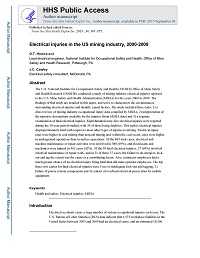Mining Publication: Electrical Injuries in the US Mining Industry, 2000-2009
Original creation date: March 2014
The U.S. National Institute for Occupational Safety and Health (NIOSH) Office of Mine Safety and Health Research (OMSHR) conducted a study of mining industry electrical injuries reported to the U.S. Mine Safety and Health Administration (MSHA) for the years 2000 to 2009. The findings of that study are detailed in this paper, and serve to characterize the circumstances surrounding electrical injuries and identify causal factors. The study included three tasks: 1) a direct review of mining industry occupational injury data compiled by MSHA, 2) interpretation of the narrative descriptions available for the injuries (from MSHA data) and 3) a separate examination of fatal electrical injuries. Eight-hundred sixty-five electrical injuries were reported during the 10-year period studied, with 39 of those being fatalities. This makes electrical injuries disproportionately fatal with respect to most other types of injuries in mining. Electrical injury rates were higher in coal mining than noncoal mining and, within the coal sector, rates were higher in underground operations than in surface operations. Of the 865 total cases, electrical and machine maintenance or repair activities were involved in 580 (69%), and electricians and mechanics were injured in 362 cases (42%). Of the 39 fatal electrical injuries, 27 (69%) involved electrical maintenance or repair work, and in 21 of these 27 cases, the failure to de-energize, lock-out and tag the circuit was the cause or a contributing factor. Also, contractor employees had a much greater chance of an electrical injury being fatal than did mine operator employees. The top three root causes for fatal electrical injuries were 1) no or inadequate lock-out and tagging, 2) failure of power system components and 3) contact of overhead electrical power lines by mobile equipment.
Authors: GT Homce, JC Cawley
Peer Reviewed Journal Article - March 2014
NIOSHTIC2 Number: 20045315
Trans Soc Min Metal Explor 2014 Mar; 334:367-375
See Also
- Content source: National Institute for Occupational Safety and Health, Mining Program


 ShareCompartir
ShareCompartir
